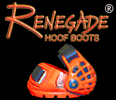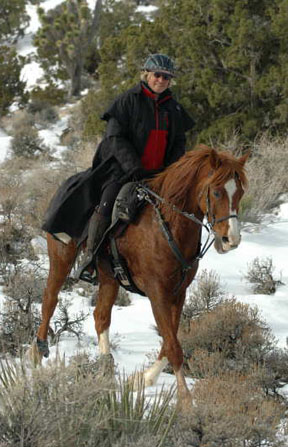
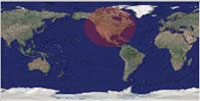
Requires Google Earth
Mojave National Preserve, CA
2008 - Merri Photos

Day 1 || Day 2 || Day 3
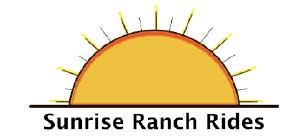
Official Event Website
Eastern Mojave Scenic Day 1
Images by Steve Bradley
.jpg)
.jpg)
.jpg)
Eastern Mojave Scenic Day 2
Images by John Teeter
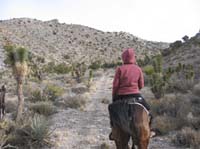
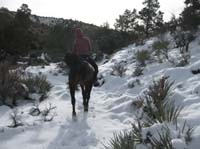

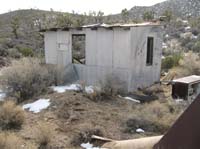
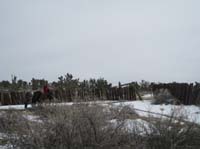
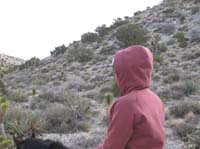
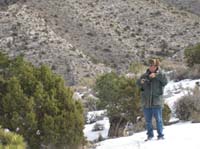
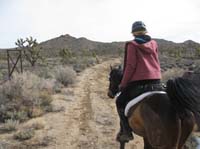
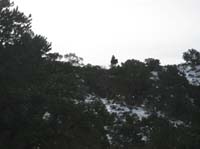
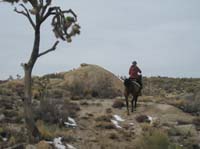
Home || John's Photos || Steve Bradley photos || Karen's EMS blog || Steph's story
Steph & John at EMS
Gotta Go!Well we hemmed and hawed about going to the ride - the 3 day East Mojave Scenic - gorgeous high desert country on the eastern border of California, about an hour out of Las Vegas. The forecast was rain, then snow, wind, cold... we all decided to bag it. (It would have been Rusty and his 2 horses traveling with John and I, and Brian and Darla - who would get a ride in and then head back to Canada.) So we went to the Friday night ballet instead. Kevin got us passes, and we went out to dinner and then watched a fantastic production of Romeo and Juliet. Really lovely. Congratulating ourselves on a good decision to stay home, do the ballet, save some money. ...more
Day 2 - spectacular!
Well we did it, and it was totally worth the drive and hassle of packing (quickly) to get here. We rode from base camp up to the most amazingly beautiful canyon - with a wild variety of flora - and a floor of fresh snow. Agave, cactus (barrel, prickly pear, cholla ... you name it), joshua trees, grease wood, iron wood, all sorts of small 'bushes' that I couldn't identify. At the highest points we got into juniper and even pinion pine. Windy single track trail... beautiful..
...more
Day 3 - tired and happy!
Another awesome ride, I'm tired and happy :) Clydea and I rode up front together all day, along with Christoph and Crockett. I don't think there were a lot of riders starting - it was a pretty scary weather forecast, and some folks were done after 2 days, and some had to get back and go to work. It was a very mellow start, no speed demons in this pack.
...more
THE EASTERN MOJAVE SCENIC RIDE
The Duck family and friends welcome you to the Eastern Mojave National Preserve and the fourth annual Sunrise Ranch Ride in the Eastern Mojave National Preserve. We hope that you will take the weekend to relax and enjoy the unique and varied scenery of the Eastern Mojave. This year we have over twice the number of pre entries as last year. Please inform yourselves about the event.
Forty years ago, while working for the Valley Wells Ranch, headquartered just north of the rest area, I had the opportunity to see the desert in a different and more appreciative light. I hope that you will take the time to notice the great variation in animal and plant life that exists in this harsh but beautiful high desert. While travelers on the Interstate fly through this “barren desert” and miss what it has to offer, you will have the opportunity to see more varied forms of plant life than what you have probably experienced on other rides, as you and your horse pass through at a more leisurely rate. This year we have moved the trails out of the worst sandy areas west of camp. We have made use of more trails east of Cima Road and on top of Cima Dome. We hope that you will find this to be an improvement over past rides here in the Preserve.
On the first day our ride starts by visiting Tin Can Alley, an important culture site, where remnants of early California Rednecks, disposed of their unneeded cans. Dumping ones cans and trash in the remote desert washes was a favorite pastime of earlier desert dwellers and is one of those fast disappearing customs of the old west. Fortunately for us, previous Desert Rednecks thoughtfully left us something to remember them by and we hope you will take the time to look through the interesting old cans and bottles from yesteryear. As you head south, along the base of the Mescals, you will see signs of the mines that may have led to one of the tributaries of the River of Gold. You will need to pay attention to the trail as you pass through the Cactus Patch, making sure that your horse stays on the trail and out of the cacti. Some of you will undoubtedly discover why the southwestern cowboys always wore chaps and boots as you brush by some of the native plants. Wise desert travelers always carry a comb, pliers or Leatherman to remove the pesky spines from man and beast. The route around Cima Dome leads through unusual rock formations and a spectacular Joshua forest that has provided cover for some of the better grazing land in this part of the country. Views from the backside of Cima Dome reveal the New York Mountains, named for their skyscraper like silhouette, and the Mid Hills, through which, the Union Pacific RR and the famed Mojave Road passes.
On the second day you will ride through the heart of the Mescals on an old pack trail, used by a lost Chinese miner when he went the wong way. You will be surprised at the vegetation and scenery as you pass through the hidden valleys in the interior of the range. The view coming through Blue Buzzard Pass is spectacular and the trail off the mountain closely parallels a dinosaur trackway. You will head past the Evening Star Mine on the way to lunch on Cima Dome. We will be using some new trails over the top of the Dome before heading back to camp. From the top of the Dome, you can look to the SW and see the famous Kelso Dunes and the Devils Playground. On the third day, we will be using one of our family’s favorite trails through Lost Chinaman Canyon, past the Lost Chinaman Mine. Remnants of the original pack trail still remain and have been improved since the first riders used it on the Lost Padres ride a few years back. After coming through Blue Buzzard Pass you will head to the Rim of the World Trail, overlooking the Nevada desert. You will pass behind Kocoweef Peak, home of the famed Mojave River of Gold and then through an old mining district before returning to Shadow Valley and lunch on Cima Dome. We will use a trail that will complete our circumnavigation of the Dome and return to camp via the Sevenmile corrals. Unfortunately, keeping out of the deep sand means that we will miss the famous Mojave Phone Booth, where callers from all over the world tried to communicate with desert dwellers. Hardy souls who took turns watching over the Phone Booth on special telephone days, received interesting calls from all over the world. It is reported that Sargent Zeno, of the Pentagon, made calls to the famous booth, in the days before the NPS removed it. Those who have an interest in this unique desert attraction should do a search online for the Mojave Phone Booth. While marking trail last year, I ran into the nephew of the man who claims to have had the phone booth installed. Small world.
The Mojave Desert, while sometimes harsh and forbidding, is a fragile and delicate ecosystem. You should learn to live with the desert and give thought to what you are doing during your visit here. Distances are deceptive and while the temperatures this time of year are forgiving, you will need to pay attention to where you are at all times. Stay on the established trails and keep the location of camp in mind. When traveling through the desert remember to respect the fragile environment, by staying on the trail and leaving nothing but your footprints, to mark your passing. This is the time of year that the desert tortoise is moving about and the young animals may possibly travel across your path. Should you observe one of these protected species, please take care to remove it from the trail and possible harm. You should also check the shaded area under your vehicles prior to moving them, as tortoises are sometimes found resting in the shade, only to be killed when the vehicles move. DO NOT DRIVE ACROSS FAGILE PLANTS AND SOIL. The NPS, along with the BLM and Forest Service now requires all hay brought onto federal lands to be certified weed free. We will provide weed free grass/alfalfa mixed hay at lunch. However, you will be able to use your regular hay in camp, as we are camping on private ground. Respect these requirements and make sure you don’t introduce non-native plants to the area with your horse feed. All traces of our passing must be removed, which means, among other things, that any hay or feed placed on the ground at lunch stops must be removed when you leave the area. You are responsible for the actions of your crews; make sure they live up to the spirit and letter of the law. Vehicles are restricted at lunch stops. No more than three vehicles are allowed at lunch stops. Due to the limited number of vehicles allowed, we will expect your crews to offer assistance to ride management and other riders, should they be permitted to travel to the control points. We make a real distinction between rides and races. This is definitely a ride, not a race. If you have a problem with that you should not come. There are lots of other events that focus on racing and those looking for the thrill of victory will find them more to their liking. The focus of this ride is to visit the East Mojave and ride in harmony with your equine partner, not to rush through it so fast that you miss what desert has to offer. If your focus is racing, you will not have a good time. This is a place to train horses and relax and there is no glory in riding this trail as fast as possible. We expect you to slow down if encountering hikers or other park visitors. We expect you to ride in a manner that you can watch for and avoid tortoises and other Park residents. By the time the sun sets on Sunday evening we hope you will have made new friends and found a new appreciation for this wild land. Our previous performances on this ride have left lasting and favorable impressions on the National Park Service. Lets make sure they stay positive.
Footing in the valleys is generally good, while footing in the Mescals is generally rocky. The rocky sections however, are generally on a soft base so that most horses do fine without pads, if ridden with care. As with any ride however, the Duck recommends some sort of hoof protection. Easyboots over a pair of shoes is cheap insurance. Perhaps the best aid for keeping horses from becoming sore footed is simply to look where you are going. While the trail is usually flagged down the easiest route, there is often another path to the side of the marked trail that will offer a better place for your horse to place its feet. Prudent riders will look for these alternatives. None of the natural obstacles in the trail have been marked, so you are expected to pay attention to what your horse is doing. There are rocks and holes that can severely injure a horse. In addition to all of the normal trail hazards, almost everything growing in the desert has thorns for protection. These thorns will cause painful wounds that will hurt you and your horse. The trails are marked with different colored ribbons tied to clothespins. We use different colored ribbon and place these markings on both sides of the trail so you will not get confused trying to remember what color ribbons you are supposed to follow, nor will you have to pay attention to what side of the trail they are on. There may also be flour marking important turns, if we get around to it. Maps and written directions, with GPS coordinates are provided as aids to those who can read. Should Sargent Zeno, or members of his vandal gang, remove or alter the ribbons, your maps and directions will keep you on course.
Remember this is just a ride and that you are doing it for fun. Your happiness and rewards should depend upon spending time in the outdoors with your equine and human friends. We will try to have water available at strategic places on the trail, providing nothing happens to the water truck or its drivers. There are many things to go wrong during the management of a ride and the failure of a water truck is perhaps the most serious. Fortunately horses can go 50 miles without water, and prudent riders will always ride with enough reserve to do just that, should all else fail. Should you come upon an empty water tank that appears to have a mud hole around it, you can assume that some inconsiderate rider, or riders, in front of you have chosen to sponge their horses instead of leaving the water for your horse to drink. You should make note of who those villains were and take care of them at a later date. If you ARE one of those villains and have been inconsiderate in the past, you should repent now, while you have the chance. Water does not come out of a faucet. It comes from fragile wells and is hauled at great expense. Desert travelers depend on it for survival and those who waste it are looked upon with disdain. While we intend to do our best to provide you with the essentials, the ultimate desert survivors are those who always keep enough in reserve that they will overcome any unforeseen difficulties. Depend only on yourself and you will never have to play the blame game.
If you are a new member of the XP Riders, you should familiarize yourself with the veterinary procedures and make sure that you understand that you are the only person ultimately responsible for your horse’s welfare. Even the most novice rider has an insight on their horse’s condition that can exceed that of the finest veterinarian. Riders should learn to develop the skills necessary to keep in tune with the true condition of their mount. While we have the means to offer standard emergency therapy to sick and injured horses, we are a long ways from significant medical help. Seriously ill or injured horses should be transported to the LA or Las Vegas area. We have over twice the number of horses entered for this years ride. This creates a problem as there is a shortage of veterinarians. If you depend on veterinarians to get you through a ride, you should not attempt to start. If you do start and fail, that burden rests solely on you, not ride management, or the veterinarians that may be here. The vets are here to act as AERC veterinary judges, not diagnosticians or treatment vets. IF YOU ARE UNABLE TO ACCEPT COMPLETE AND UNEQUIVOCAL RESPONSIBILITY FOR YOUR HORSES WELFARE, YOU ARE NOT WELCOME AND YOU SHOULD LEAVE THIS RIDE AND THIS SPORT. You are the only one who can be responsible for your animals well being. The weekend forecast, at the time this was written is for mild daytime temperatures and chilly nights. Those of you from the Promised Land will define “chilly” as “freezing ass cold”. Those of us from Alaska will define it as “balmy”. Good weather is in the eye of the beholder, so put on an extra blanket at night, carry a jacket, in case you end up spending an evening on the trail, and enjoy the great outdoors. At the present there is a 20% chance of showers on Monday. That means there is an 80% chance of being dry. Think positively but bring a slicker.
You are camping at the home of Al and Nannette Young. The future of the ride also depends on how you treat them and their land. As previous members will notice, they have done a lot of landscaping in the past years. The horses that camp in the yard create dust that they have to live with throughout the year. We therefore ask that you refrain from bringing your horses with you when you come inside the chain link fenced area. The obvious exception will be for vet checks. The proper way to leave your camp is to smooth out any holes that your horse has made and to spread the manure so that it will dry. Cover the disturbed area with a LIGHT covering of hay or straw. This does not mean that you leave a huge pile of hay and manure for poor Annie to pick up. Joseph has built us an attachment for the water truck that will allow us to keep some of the dust down. Be sure to thank him, as all he ever gets from the Duck is a hard time. We have placed three outhouses in camp and there are restrooms available in the store. Showers are available for a nominal fee, as well as various sundries at the store. Al has purchased two new tow trucks to assist those of you who are unfamiliar with desert driving conditions. He appreciates your business and needs the money, so there is no need to pay any attention to where you are driving. There is diesel fuel and gas available at the station. It isn’t cheap, but it is good. Bear in mind that the delivery charges are exorbitant, and that drives the cost way up. But, bear in mind that the service station makes it possible to have a camp with water in a barren desert.
PLEASE MAKE SURE THAT YOU KNOW HOW OUR ENTRY BOX AND CARD SYSTEM WORK.
We have an entry box that will be available and open until 21:00 (9:00PM). You are required to put a 3x5 card in the entry box with your name, your AERC number, your horses name, your horses AERC number your weight division. If you only intend to ride part of the day, this is the place to make your intentions known. You are not entered in the ride until you have done this. If you change horses, you will need to put a new card with the correct information in the entry box before the ride starts. Any changes after the ride starts must be in writing and accompanied by a $10.00 post entry fee. Verbal changes yelled to us during the confusion of the start will no longer work. The Duck and Annie are getting old and we are having trouble remembering our names and why we are doing this, so we can no longer be expected to remember these last minute changes that people yell to us during the start of the ride. Your cooperation with this policy is mandatory.
Starting in 2004, we no longer offered completion awards of any consequence. In fact, the completion awards will be an insult and the miniscule plaques for first place and best condition will be unworthy of any great effort. We do not offer top ten awards, or even first place in the divisions. We do offer T-shirts and coffee mugs for all of the participants, including those who ride less than the full mileage and are only interested in riding for club miles. Those who entered in time, will receive mugs with their names imprinted on them. Late entrants may end up with plain ride mugs. Those who entered, but failed to show up and did not notify us, will have their mugs turned to the wall and their mugs will be used for target practice during the annual Duck Club Fishing Party this summer. Our faithful secretary and statistician, Karen “The Numbers” Chaton will keep track of member’s mileage for the placing of the XP Annual Awards, which are presented at the Cuyama XP Ride.
We constantly have people wonder how we do these rides “all by ourselves”. The sometimes not so obvious answer is that we have an enormous support group. We always have numerous members of the XP riders who pitch in at P&R stops, work on trail projects, and donate time, money and goods for the rides. Without this support we wouldn’t have a ride. Remember those who work so hard and have given so much to their fellow XP riders. We thank all of the above along with our regular sponsors.
Good luck and have a great ride.
FW, Annie, Karen and the Duck Gang


